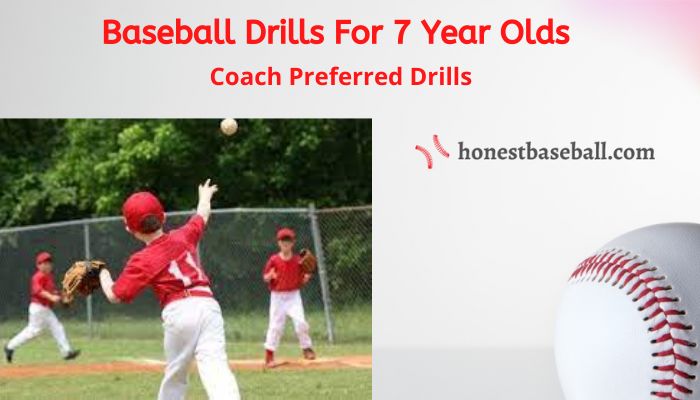Players ranging from 7 to 8 year olds are susceptible to any sport. And as a coach or parent, you shouldn’t pressure them with a serious training plan. Instead, make it fun and exciting. Add very easy-to-adapt baseball drills for 7 year olds during practice sessions.
Remember, your goal isn’t to make them the master of the puppet. Rather you should find whether they fit in this game or not. That’s what I’ve learned in my decades of journey in baseball, both as a former minor league player and a coach.
Drills are fundamental to all baseball skills. These are experimented with to make players habituated with body movements for a real game. So, when grooming your kids to learn baseball drills, avoiding mistakes and wrong gestures is inevitable.
There are drills in different categories, including pitching, hitting, catching, and fielding. In this article, I’ll share the best baseball drills I found quite progressive for kids aged 7, 8, and 9.
Fundamentals to Focus On
At 7 years old, the goal isn’t to master baseball’s complexities but to grasp the sport’s fundamentals. Here are key areas to emphasize:
- Throwing Mechanics: Teaching proper grip and follow-through is essential. Kids should learn to step forward with their opposite foot when throwing to help with accuracy and power.
- Catching Technique: Encourage using two hands to secure the ball and tracking it with their eyes. Start with soft or foam balls to build confidence.
- Hitting Basics: Batting practice should focus on stance and swing. Introducing concepts like “keep your eye on the ball” and “follow through” will be helpful.
- Base Running: Kids should know how to run through first base and understand the importance of quick starts from the batter’s box.
- Understanding Rules: Gradual exposure to basic rules—such as the roles of each base and the objective of getting outs—helps create familiarity with the game.
How to Adapt Drills for Home Practice
Adapting baseball drills for home practice is a great way to help young players sharpen their skills while having fun outside of structured team practices. Here are some ways parents or guardians can make these drills feasible at home:
- Use Safe Materials: Substitute hardballs with tennis balls or foam balls to prevent injury and build confidence, especially in tight spaces.
- Create a Mini Baseball Field: Set up makeshift bases using objects like cones, mats, or plastic containers. This helps kids become familiar with base-running strategies even in smaller spaces.
- Solo Drills: Parents can encourage children to practice throwing against a wall with a target marked on it to improve accuracy. They can also try shadow batting (practicing swings without a ball) to work on technique.
- Incorporate Household Items: Use buckets, chairs, or hula hoops to set up catching or throwing drills. For example, challenge kids to toss a ball into a hoop from different distances to improve their precision.
These small at-home sessions can create a fun learning environment that keeps kids practicing regularly without making it feel like a chore.
3 Hitting Drills for 7 Years Old Baseball Game Players
Young kids always love to bat a ball. And you can take advantage of this habit by implementing some rules. The following baseball drills for 7 year olds age group will build their foundation. It’s essential to monitor their progress and how they perform all baseball drills.
1. Split Hand Drill
Starting with one of the most casual drills, split hands. This drill helps improve kids’ hitting order. Also, practicing this drill is good for the top hand’s betterment. And it’s needless to say how effective this is for swing motion.
The best part of this batting drill is the kid doesn’t need any partner; they can practice all alone with the coach. You can just give them a time slot or round to provide it with discipline.
How to Perform Split Hand Hitting Drill?

In order to perform split hand drills, you need a batting tee, a small soccer goal post, a kid’s baseball bat, and a ball. You can also skip the soccer post and set up the player’s position in front of a wall.
Tell the kid to stand beside the tee. Place the soccer post 5 to 6 ft. from the hitting base.
Now, the kid has to follow the regular hitting stance. And as the name suggests, (s)he should also split his hand, keeping a .5-inch short distance.
There are 2 methods to practice this drill – hitting the tee and hitting the ball. Firstly, the player’s target is to hit on the middle point of the batting tee. It’ll strengthen their top hand.
And afterward, they should try to hit the ball instead of the tee. After building the hitting strength, this method will help them work on their accuracy.
I discovered another method to make this challenging and exciting. You can place a square or circular card, box, or any object and hang that with the post.
Ask the little guy to hit the object with the ball. Each player hits the ball 10 times. The more accurate hit one can make becomes the winner.
Advantages
- Strengthens player’s hand, elbow, wrist
- Develop the hitting accuracy of the player
- Helps to adapt to the regular swinging motion
2. Bottle-Cap Drill
Young hitters often struggle with hand-eye coordination. So, it’s essential to hone a child batter’s synchronization. The next drill is a purely scientific approach to developing their batting skills and hand action.
The main goal is to let the player practice hitting with small objects instead of regular baseball, such as bottle caps, golf balls, tennis balls, etc. Our brain’s neurons work uniquely.
When the player gets used to hitting smaller objects, their hands and eyes operate more strategically to hit with accuracy.
And if we change the small object to a bigger one or baseball, it becomes easier for them to hit. Bottle-cap hitting drill is based on the same strategy.
How to Perform Bottle-Cap Hitting Drill?

To perform the bottle-cap hitting drill, the player has to take his batting position on the home plate. You should take your position 5-7 ft. away from the batter with some water bottle caps.
Now, throw the caps one by one towards the player and ask him to hit. He’ll surely miss many shots as the floating frequency of caps is very inconsistent. As a result, it tumbles so much. But the kid should continue trying.
Every time he hits the cap, he gets a score. If he misses a shot, he gets a minus score. He needs to reach a score of 5 or 10, as you prefer.
The good part of this drill is that you can instantly witness his batting improvement and accuracy after a few rounds. Just switch back to regular baseball. The batter will be able to hit with more accuracy.
Advantages
- Helps improve hand and eyes coordination
- A great drill to develop hitting accuracy
3. String Drill
No matter how often you say it, kids lose their leg balance during hitting. Either they strive with the front leg or sometimes with the back lag.
String hitting drill is something to help them balance and habituate with the appropriate leg movement, stances, and strides.
How to Perform String Hitting Drill?
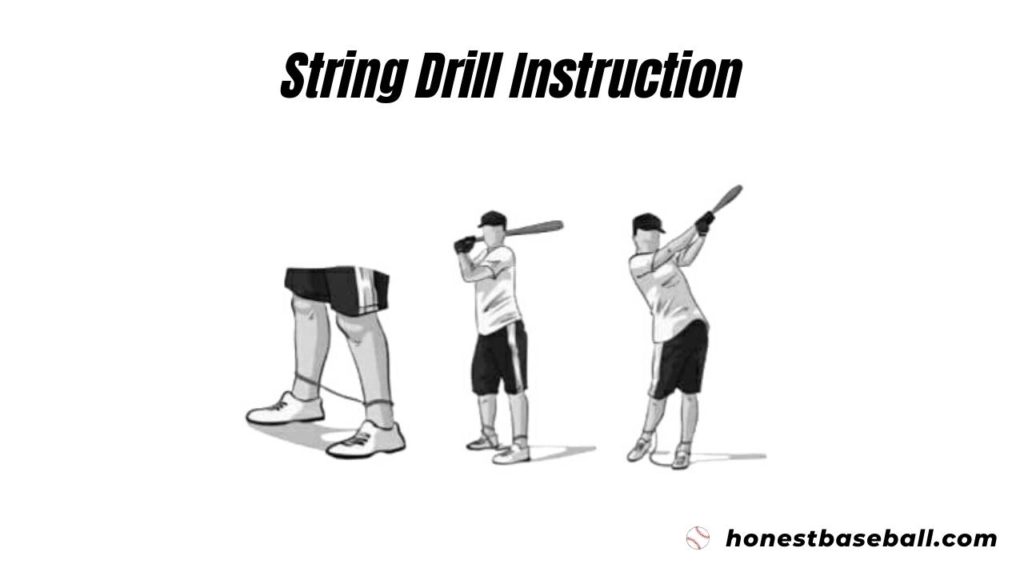
The rules of string drills are relatively straightforward. Ask the batter to stay in the batting position. Get a measurement of his comfortable stride. Then tie up his ankles with a string or rope, but don’t make it too tight.
If you say “hit,” the kid should follow the regular hitting action. But instead of hitting the ball, he’ll stride and swing in the air.
You tell him to stop when the swing is finished, and the little nerd should freeze his movement right in there. Take a 2-second interval and ask him to return to his normal batting posture in the strike zone. He just needs to repeat the pose in 8-10 reps.
Advantages
- Helps to control his swings
- Players can avoid over-strides if practicing regularly
- Doesn’t need any partner or coach support
- Can be practiced at home or anywhere
3 Pitching Drills for 7 Years Old Baseball Players
When it comes to pitching practice for a 7-9 years old kid, you should focus on posture development in the beginning. Leg work, hand movement, eyesight, everything is paramount.
Later, you can work on their swings, pitching styles, and others. The baseball drills for 7 year olds age group will help them create a strong pitching foundation.
Hi-5 Pitching Drill
Carrying on the hand movement in the proper manner is the core of any pitching style in baseball.
Young pitchers often encounter arm injuries because of wrong pitching movement. Throwing the ball around the ball causes these injuries the most.
On the other hand, pitching through the ball can reduce this risk. This Hi-5 pitching drill can help them work in this regard.
It’s a parents-friendly pitching drill, too, as anyone can practice the drill anywhere, like at home, on the ground side.
How to Perform Hi-5 Pitching Drill?

In the Hi-5 drill, first, the kid takes his pitching position. He should stick in a posture where he’s supposed to throw the ball but shouldn’t throw it. Tell the kid to bend his front leg while pointing the foot towards the batter.
You should sit on the knee beside him, following the images below. Keep your one hand as a wall, and the pitcher should stand his pitching hand against yours, just like making a hi-5 while holding the ball in his hand. His pitching hand should get an “L” shape.
The pitcher’s goal is to keep pressuring against your hand and finish the pitching action through your hand. He should keep a 1-second interval between every push. You can continue up to 10 reps before giving the pitcher a break.
“Don’t do too many reps without a break. It may cause arm injuries to the pitcher. Also, the pitcher shouldn’t soft toss the ball.”
Advantages
- Develops hand strength of a pitcher
- Helpful drill to learn following through a pitch
- Can be practiced at home
- Mound Back Drill
Another easy-to-learn, simple drill is the mound back drill. It helps seven-year-old age group baseball players develop their pitching strength and accuracy. However, this drill aims to help them learn proper leg bending while pitching.
Unlike beginner pitching drills, you can’t complete this drill at home. As the name suggests, the baseball field mound position is essential for grooming the drill.
How to Perform Mound Back Pitching Drill?

Tell the pitcher to take a position nearby the mound. And you should play a partner or coach role as a hitter though hitting isn’t necessary.
The player should throw the ball following his pitching style toward you. One thing he must follow is the front bent while throwing the ball.
He has to start from his back body, load, and pitch the ball. While in the finish line of the pitching movement, the front leg should be bent, as shown in the image. The head should keep a straight position towards you also.
Catch the ball and throw it back to him. And he has to continue this throwing 10 to 15 times.
Advantages
- Helps in keeping up a proper leg bending while pitching
- Sharpens pitching strength of youth baseball players
- Develops throwing accuracy to play as a fielder
Pitching Eye Drill
If you ever saw a young player pitching the ball while didn’t have any idea of where his head was pointing, that fellow lacks eye drills in his training plan.
Often most beginner coaches or baseball managers ignore the importance of eye coordination during pitching. They skip drills, which can improve the eyesight of the pitcher. The reasons are apparent, though.
Eye drill is one of the fun baseball drills. This requires more patience from the player’s end. The goal of this drill is to maintain proper eyesight while pitching the ball. Let’s take a look at how a player can achieve this milestone.
How to Perform Eye Pitching Drill?
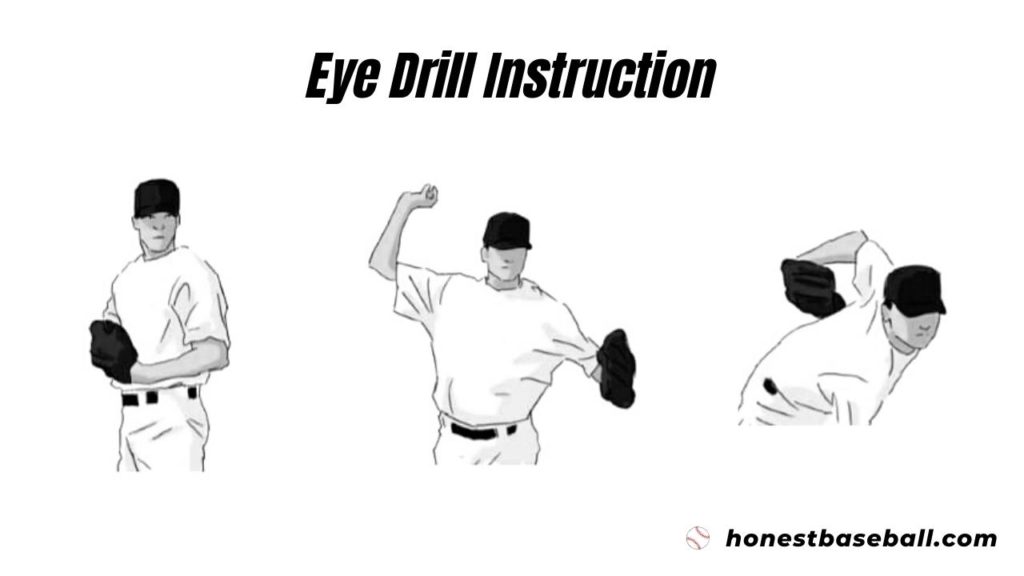
The player should take a position on the baseball ground with the glove and ball. On the flip side, get your place on the home plate.
Now, just like regular pitching, he should load up, follow through with the movement, and throw the ball towards you. The pitcher should maintain a steady pitching speed while throwing.
Also, he should keep his eyesight to your mitt from the beginning to the end of the pitch.
“In the baseball game, a mitt is the specially designed gloves used by the catchers. Here, the coach should wear it up.”
Advantages
- Help pitcher maintain a hand-eye coordination
- Highly effective for accuracy improvement
- Pitchers can predict hitter’s movement
3 Fielding Drills for 7 Years Old Baseball Players
In this section, I’ll share the basic baseball drills for 7 year olds to improve player movement in an actual game. These drills are advised to follow, considering the target player’s age.
Hip Drill
For baseball fielders, sideway and linear movements are crucial. In the meantime, keeping a solid base is also inevitable.
The hip drill works on both segments. It can be practiced as a partner drill or team, depending on whether you’re coaching a single guy or multiple.
Another good aspect of this drill is it doesn’t require a baseball field. You can practice indoors or outdoors at your convenience.
How to Perform Hip Fielding Drill?
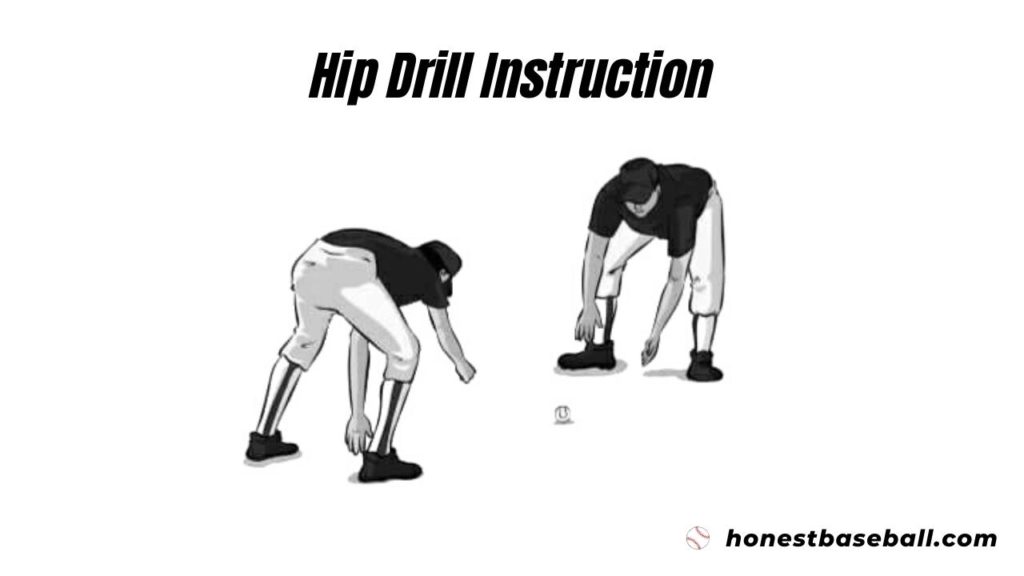
If you and the kid are alone, take your position at a four ft. distance from each other. If there is a team of daredevils, line them up face to face accordingly.
Both of you should bend down to the ground just like in the images. Your hands should almost touch the ground. Your legs should have a shoulder-width apart gap. It’ll help you and the player to maintain adequate balance.
Now roll the ball towards the player. He should catch or grab the ball barehanded and throw it back to you.
"While fielding the ball, the player should grab or catch it first and then swipe the ball to the glove hand. Then again, sweep it back to the fielding hand and throw it towards you."
One thing both of you should maintain is to keep your eye contact on the ball from throwing to catching.
Roll the ball to the player’s left and sometimes right to make this drill more effective. In that way, he can improve his sideway fielding action.
Advantages
- Strengthens hip muscle and develops the muscle memories
- Improves eyesight on the ball while fielding
Two Ball Drill
Outfielders have to be active throughout the games. At any moment, balls can arrive in their line. Hence, a little bit of conditioning drill is vital for those hustlers.
Although I don’t prefer conditioning at this age, if your kid is performing poorly as a fielder, it might help him.
How to Perform Two Ball Fielding Drill?
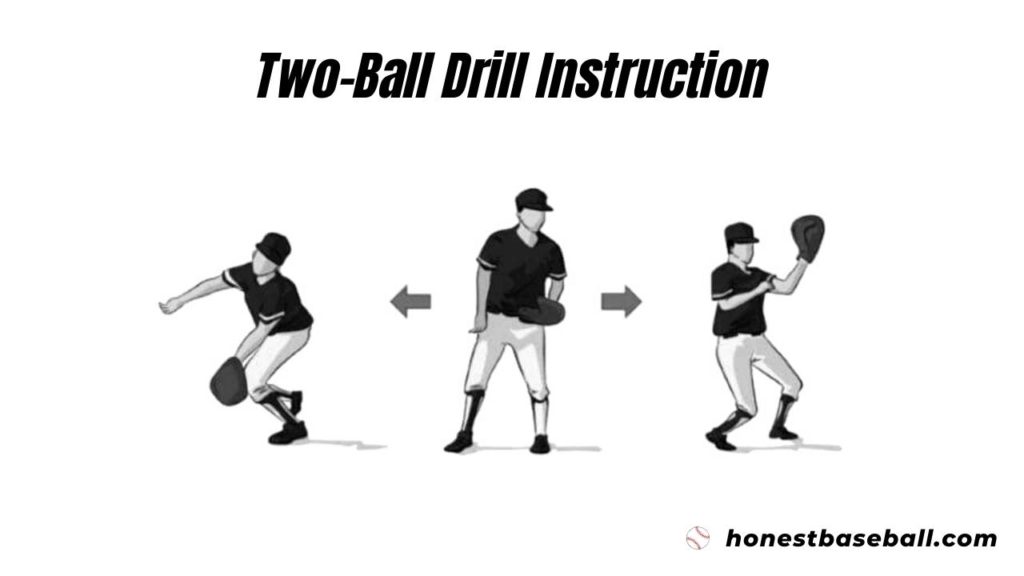
The kid should get his position 30 ft. away from you, wearing the glove. Throw some fly balls or ground balls towards him first. He has to field it and throw it back to you.
Next time, throw a ground ball, and the player has to follow the same instructions. You can then try line drives consequently. To make it more challenging, you can sometimes throw the ball right and left.
Advantages
- Good drill for the betterment of the footwork momentum
- Works as a conditioning drill
Crow Hop Corner Drill
Most of the time, outfielders have to tackle throws from long distances. So, it’s better if you can polish up your kids’ throwing skills from a very early stage. And the crow hop corner drill is proven helpful in this scene.
As it’s a popular fielding drill, many think it’s only related to the arm exercise, which it’s not indeed. The goal of the drill is to create the required momentum for long-distance throws.
The disadvantage of this drill is that you’re going to need other players to practice drills.
How to Perform Crow Hop Corner Fielding Drill?
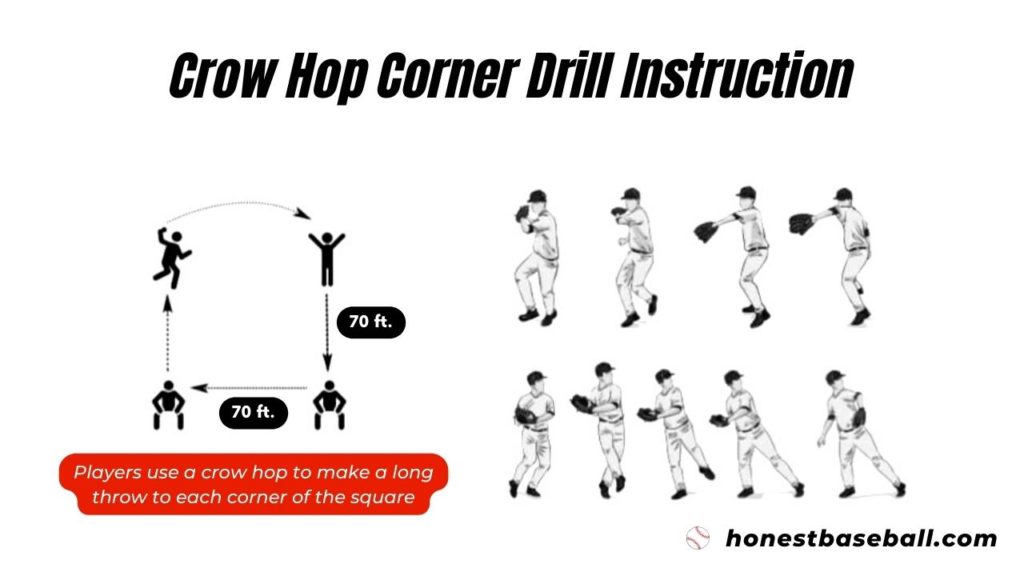
All four players should take their fielding position in a manner so that it looks like a square shape.
The distance between one player to other players should be 50 ft. from each player, in terms of the 7-year-old age group. And for older players, you can decide up to 70 ft. Mark them by 1, 2, 3, 4.
The first player should have the ball in hand. And second, third and fourth fellows should wear their gloves.
Now the first person should throw the ball toward the second guy. He should field the ball and throw it to the next member or the third fielder.
Following the rule, 3rd player and 4th player should do the same. When the 1st cycle is over, the young players should repeat this process in multiple reps.
"There is no restriction on the players' movement. They can field independently throughout their zone."
You can ask them to roll and throw a fly ball or ground ball to make them habituated to different fielding techniques. Sometimes, I level up this drill to make it harder by breaking the throwing serial, meaning players can throw the ball next to anyone.
Advantages
- Allows players to work on their ball-throwing skills
- An excellent drill for outfielders
- Help players learn to achieve different momentum while throwing
Engagement Tips for Coaches and Parents
Keeping 7-year-olds engaged during practice requires creativity and flexibility. Kids at this age have shorter attention spans, so drills should be dynamic and entertaining. Here are some tips:
- Keep It Fun: Incorporate mini-games, such as throwing competitions or home run derbies, into drills to maintain excitement.
- Encourage Friendly Competition: Divide the group into small teams for relay races or fielding challenges. This keeps the energy high while fostering teamwork.
- Rotate Activities: Change drills frequently to avoid monotony. A 7-year-old’s enthusiasm can quickly fade if they repeat the same activity too often.
- Provide Positive Reinforcement: Compliment efforts and small improvements to build confidence. For example, saying, “Great swing!” or “Awesome throw!” can make a big difference.
- Ensure Equal Participation: Minimize downtime by using rotation systems or small groups. Every player should stay involved to avoid boredom and keep the session lively.
A fun and encouraging environment ensures children develop a positive relationship with the sport, keeping them excited to come back for more practices.
Safety Considerations
Ensuring the safety of young players is paramount when conducting baseball drills. While it’s essential to keep practices fun, safety must always come first. Here are some key considerations:
- Use Protective Gear: Helmets should always be worn during batting practice. Additionally, gloves should fit properly to help players catch the ball safely.
- Choose the Right Ball Type: Soft or foam balls are recommended for beginners to reduce the risk of injury.
- Monitor for Fatigue: Kids can lose focus if they become tired, increasing the chances of accidents. Coaches should be mindful of breaks and keep sessions short.
- Safe Batting Practices: Teaching kids to drop the bat properly after swinging (as practiced in the bucket drill) helps avoid accidental injuries.
- Field Awareness: Encourage players to stay alert and be mindful of their surroundings, especially when others are throwing or swinging a bat.
By prioritizing safety from the beginning, children will feel secure and confident while learning the game. This also helps parents and coaches ensure that the learning environment remains enjoyable.
These sections build on fundamental aspects of baseball practice and emphasize safety and engagement to ensure kids have a positive and enriching experience with the sport.
Creating a Positive Team Environment
Fostering a positive team environment is essential when coaching 7-year-olds. At this stage, the primary focus should be on teaching teamwork and sportsmanship, not just skill development. A welcoming and inclusive environment ensures kids stay motivated and develop social skills alongside their athletic abilities. Here’s how coaches and parents can cultivate a positive atmosphere:
- Emphasize Teamwork Over Winning: Teach kids that baseball is about supporting teammates and learning from both wins and losses. Celebrate effort and teamwork, regardless of the outcome.
- Assign Small Roles to Build Responsibility: Giving each player a small responsibility, such as team captain for the day or equipment manager, helps them feel valued.
- Develop a Cheer Culture: Encourage kids to cheer for each other during drills and games. Positive reinforcement from peers boosts morale and builds camaraderie.
- Encourage Open Communication: Create a space where kids feel comfortable expressing their feelings, whether they’re excited about a great play or frustrated by a mistake. This helps them learn emotional regulation and resilience.
- Build Rituals and Traditions: Implementing pre-game chants or post-practice high-fives creates shared experiences that bond the team. Simple traditions can turn into fond memories that stay with kids beyond their time on the field.
A strong sense of belonging and support enhances children’s enjoyment of the sport, ensuring they look forward to practices and games.
Measuring Progress and Celebrating Milestones
Tracking progress helps kids stay motivated and gives parents and coaches a way to acknowledge growth. While winning games is a bonus, focusing on individual milestones and improvements provides children with a sense of achievement.
- Set Small, Achievable Goals: Focus on specific areas like making a solid catch, running the bases faster, or learning new rules. Small victories boost confidence.
- Track Progress Through Fun Charts: Create simple progress charts that mark achievements, such as “5 successful catches” or “2 great throws in practice.”
- Use Practice Challenges: Coaches can introduce fun skill challenges, like hitting the ball a certain distance or catching five balls in a row, to motivate kids to improve.
- Celebrate Milestones with Simple Rewards: Small rewards, such as stickers, certificates, or a “player of the day” recognition, go a long way in encouraging children.
- Highlight Improvements During Practice: Publicly acknowledging a player’s improvement reinforces positive behavior and makes kids feel proud of their progress.
Celebrating achievements—big or small—helps children build self-esteem and reinforces their commitment to learning the game.
Frequently Asked Questions
Which baseball game skills are a must for a 7 year old player?
I always prefer to work on skills in every niche while coaching young baseball players. And it’s better not to pay attention to perfection. They should explore different positions and roles on the baseball field.
On that note, a 7 year old player should have adequate fielding skills. Instead of hitting home runs, they should improve their average hitting. Having good hitting power is always appreciated.
And lastly, always try to improve their arm strength with different fielding and pitching drills. This helps significantly in the actual games.
How to improve your 7 year old’s hitting skills?
Start with easy-to-adapt batting drills first and keep multiple reps for each drill in their training chart. Split ball underhand, Bottle-Cap, and String drills are fundamental but helpful to reshape a kid’s batting skills to the next level. I’ve shared a detailed guide on these above. You can also check out essential baseball drills for 10 years old players.
How should you coach 7 to 8 year olds?
Don’t try to be a freak; rather, be a friend. Make the kid’s experience memorable. Encourage players in every training session. Talk to them. Learn their struggling points during training.
Keep drills in their practice plan. Don’t add boring exercises to enhance your techniques or strength. Instead, focus on the drills that they love to participate in. That’s how you should coach a kid in the baseball game.
How to teach my kid to hit harder?
To make them hit hard, you should work on their strength. Baseball players can level up their strength from two sources. Firstly, their diet. Try to add sunflower seeds to their morning or evening snacks.
Secondly, add some batting drills in their practice plan, mainly focused on boosting the batter’s strength. You can try one-handed, flamingo, or medicine ball toss hitting drills.
What’s the average age for kids to get good at a baseball game?
The answer may vary widely from player to player. Every player has a unique specialty and struggle. Some may perform well at batting; some may have the potential to be great pitchers. In any sense, it may take up to 13 years to identify their strength.
At what age is a kid able to play catch a baseball perfectly?
If they are under a regular training plan, 8 to 10 years is good enough to see them play catch baseball perfectly. To make them good at catching, try regular fielding drills during practice.
How can you make the baseball game exciting for kids?
To make the baseball game more exciting, improvise with the drills, and turn them into fun baseball drills. Give them competitions, scoring during the learning curve.
And make sure not to overestimate their strength by pushing too far while drilling. Allow intervals between every rep.
How can I make my kid hold back weight when hitting?
K-posture hitting drill is the immediate solution to get kids used to keeping body weight on their back. However, it’s a bit of an advanced drill for 7 years old batters. You can start with the string drill that I demonstrated above for kids at that age.
Were all MLB players good in middle school and little league?
Well, in most cases, MLB players caught selectors’ attention in little league or middle school by showing their potential. But it’s not always the case. Take Yermín Mercedes as an example.
What’s the minimum age to play in the MLB?
United States players’ minimum age to qualify in major league baseball is 18. And for international players, the age restriction is 17.
Wrapping Up
That was all about 9 essential baseball drills for 7 year olds. The string, split hand, and bottle-cap drills are incredible to improve their hitting strength. Regarding pitching drills, hi-5, mound back, and eye drills seem quite effective.
Also, my high school baseball players showed significant improvement with the hip, crow hop corners, and two ball drills for fielding.
I would love to hear how your kid is progressing with my recommended baseball drills. Make sure to buzz me with your further queries. Cheers!
Check out more on kid’s baseball practice plans:
7 Youth Baseball Hitting Drills – Hit To Stars Like A Pro!
Baseball Drills for 8 Year Olds | Fun Drills
Baseball Drills For 10 Year Olds- The Rulebook

Hello everyone. My name is Jason Butler, and I live in California, America. I was a professional AAA Minor League Baseball player. I lost my chance of playing MLB for injury issues, but I did not lose my love for baseball. I attended the coaching training program and am now working as a coach in a small school in San Diego.
I always love to share my experience and knowledge if that can help you. Play baseball, and stay fit.
